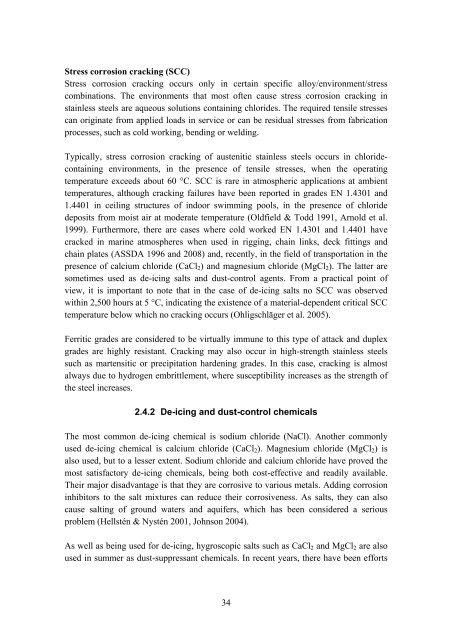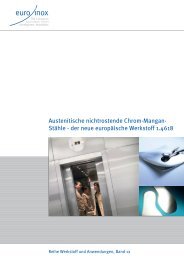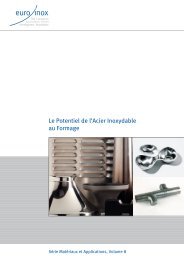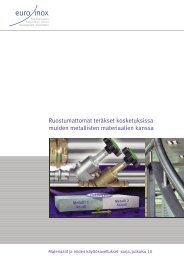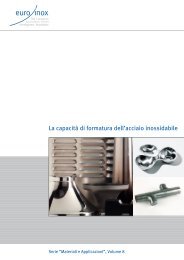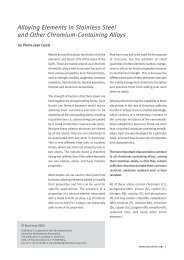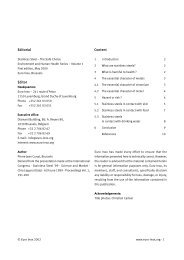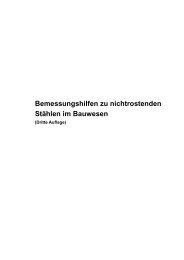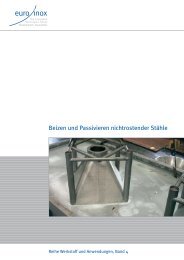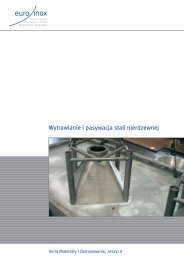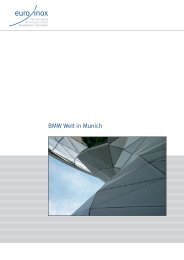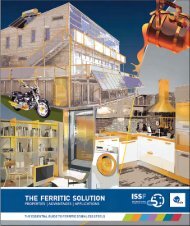Innovative Stainless Steel Applications in transport ... - Euro Inox
Innovative Stainless Steel Applications in transport ... - Euro Inox
Innovative Stainless Steel Applications in transport ... - Euro Inox
Create successful ePaper yourself
Turn your PDF publications into a flip-book with our unique Google optimized e-Paper software.
Stress corrosion crack<strong>in</strong>g (SCC)<br />
Stress corrosion crack<strong>in</strong>g occurs only <strong>in</strong> certa<strong>in</strong> specific alloy/environment/stress<br />
comb<strong>in</strong>ations. The environments that most often cause stress corrosion crack<strong>in</strong>g <strong>in</strong><br />
sta<strong>in</strong>less steels are aqueous solutions conta<strong>in</strong><strong>in</strong>g chlorides. The required tensile stresses<br />
can orig<strong>in</strong>ate from applied loads <strong>in</strong> service or can be residual stresses from fabrication<br />
processes, such as cold work<strong>in</strong>g, bend<strong>in</strong>g or weld<strong>in</strong>g.<br />
Typically, stress corrosion crack<strong>in</strong>g of austenitic sta<strong>in</strong>less steels occurs <strong>in</strong> chlorideconta<strong>in</strong><strong>in</strong>g<br />
environments, <strong>in</strong> the presence of tensile stresses, when the operat<strong>in</strong>g<br />
temperature exceeds about 60 °C. SCC is rare <strong>in</strong> atmospheric applications at ambient<br />
temperatures, although crack<strong>in</strong>g failures have been reported <strong>in</strong> grades EN 1.4301 and<br />
1.4401 <strong>in</strong> ceil<strong>in</strong>g structures of <strong>in</strong>door swimm<strong>in</strong>g pools, <strong>in</strong> the presence of chloride<br />
deposits from moist air at moderate temperature (Oldfield & Todd 1991, Arnold et al.<br />
1999). Furthermore, there are cases where cold worked EN 1.4301 and 1.4401 have<br />
cracked <strong>in</strong> mar<strong>in</strong>e atmospheres when used <strong>in</strong> rigg<strong>in</strong>g, cha<strong>in</strong> l<strong>in</strong>ks, deck fitt<strong>in</strong>gs and<br />
cha<strong>in</strong> plates (ASSDA 1996 and 2008) and, recently, <strong>in</strong> the field of <strong>transport</strong>ation <strong>in</strong> the<br />
presence of calcium chloride (CaCl2) and magnesium chloride (MgCl2). The latter are<br />
sometimes used as de-ic<strong>in</strong>g salts and dust-control agents. From a practical po<strong>in</strong>t of<br />
view, it is important to note that <strong>in</strong> the case of de-ic<strong>in</strong>g salts no SCC was observed<br />
with<strong>in</strong> 2,500 hours at 5 °C, <strong>in</strong>dicat<strong>in</strong>g the existence of a material-dependent critical SCC<br />
temperature below which no crack<strong>in</strong>g occurs (Ohligschläger et al. 2005).<br />
Ferritic grades are considered to be virtually immune to this type of attack and duplex<br />
grades are highly resistant. Crack<strong>in</strong>g may also occur <strong>in</strong> high-strength sta<strong>in</strong>less steels<br />
such as martensitic or precipitation harden<strong>in</strong>g grades. In this case, crack<strong>in</strong>g is almost<br />
always due to hydrogen embrittlement, where susceptibility <strong>in</strong>creases as the strength of<br />
the steel <strong>in</strong>creases.<br />
2.4.2 De-ic<strong>in</strong>g and dust-control chemicals<br />
The most common de-ic<strong>in</strong>g chemical is sodium chloride (NaCl). Another commonly<br />
used de-ic<strong>in</strong>g chemical is calcium chloride (CaCl2). Magnesium chloride (MgCl2) is<br />
also used, but to a lesser extent. Sodium chloride and calcium chloride have proved the<br />
most satisfactory de-ic<strong>in</strong>g chemicals, be<strong>in</strong>g both cost-effective and readily available.<br />
Their major disadvantage is that they are corrosive to various metals. Add<strong>in</strong>g corrosion<br />
<strong>in</strong>hibitors to the salt mixtures can reduce their corrosiveness. As salts, they can also<br />
cause salt<strong>in</strong>g of ground waters and aquifers, which has been considered a serious<br />
problem (Hellstén & Nystén 2001, Johnson 2004).<br />
As well as be<strong>in</strong>g used for de-ic<strong>in</strong>g, hygroscopic salts such as CaCl2 and MgCl2 are also<br />
used <strong>in</strong> summer as dust-suppressant chemicals. In recent years, there have been efforts<br />
34


